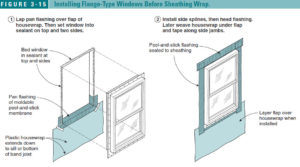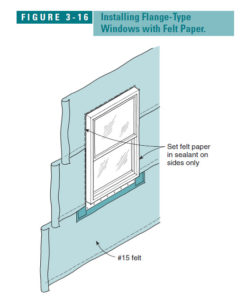Q: I am installing a new window in a garage wall in California. The window manufacturer states in the instructions that a backing (not more than 1/8 inch thick) “MUST” be installed for “open stud” construction. This is my case (open stud construction), and I planned to wrap my exterior wall with #30 felt.
So, I searched the local lumber and box stores and found a 4×8 vinyl sheathing product (less than 1/8 in thickness). The purpose for applying this backing support, as I understand, is to provide firm backing around the rough opening so that adhesive flashing can be applied and j-rolled to provide a good bond (this is in place of sheathing with OSB or plywood, for example).
So, I have cut and installed the vinyl sheathing to surround my rough opening, and started to nail it up. But, then I read your informative article. I understand that a rubberized asphalt (modified-bitumen) may interact with and compromise the vinyl backing support (I had intended the modified bitumen flashing would go over the vinyl backing support).
My intent was to use Fortiflash (Henry’s, from Home Depot) for the window flashing… but it sounds like that may be incompatible with the vinyl (assuming Fortiflash is a bitumen product). Alternatively, if I use a butyl flashing product, the article seems to suggest that there will be no incompatibility with the vinyl sheathing/backing support, but the butyl is incompatible with asphalt building paper??? Is my interpretation of this correct? If I continue to use the vinyl backing support, what would be the appropriate flashing, tape, and house wrap combination? — Rob Ericson
A: Good questions – I can see that you are paying attention to the details, always a good thing, especially around tricky issues like window flashing.
You are correct that standard self-adhesive (bituminous) flashing tape should not be used in direct contact with soft vinyl such as vinyl flashings and vinyl siding. The plasticizers, which keep the vinyl flexible, will react with the asphalt-based membrane, causing the asphalt to flow. This can degrade the flashing tape, stain the siding, and make the vinyl brittle.
However, it is fine to use standard flashing tape with the thicker rigid vinyl used on vinyl window flanges. I can’t say whether the vinyl sheathing you bought is more like vinyl siding or vinyl windows. But to be safe, you are better off using a butyl flashing tape. Henry Fortiflash is available as either an asphalt or butyl-based membrane.
Next question is whether the butyl flashing tape is compatible with asphalt felt. Manufacturers of butyl flashing tapes are not always clear on this topic. Each formulation is a little different. You need to consult the product literature or contact the manufacturer of the specific product. You may not get a clear answer as the jury is still out on this question. It depends, in part, on the amount of asphalt in the felt paper, which varies with the product.
Assuming you want to stick with asphalt-felt building paper, I would suggest installing and sealing the window directly to the vinyl sheathing and installing the felt paper over the butyl flashing tape. The plastic or foil facing of the flashing tape (Henry Fortiflash Butyl uses polypropylene) will prevent contact between the butyl and asphalt felt. The only place where you will have direct contact between the two materials is at the bottom of the window where the felt paper should tuck under the flashing tape. Here, you can leave the release paper in place on the flashing tape or use a third material to separate the butyl tape from the asphalt felt.
Henry publishes this type of window installation detail at this link. The only thing I don’t like about their detail is the lack of a window pan. This is easy to modify by wrapping the sill flashing into the opening or using a separate piece of flashing tape as the window pan and lapping it over the sill flashing, and up the side jambs by 6 in. You could also wrap the side jambs for extra protection, lapping the flashing tape over the turned-up ends of the sill pan.
It’s also best to set the asphalt felt paper into a bead of sealant on the side jambs (NOT the top and bottom which need to drain). You’ll need a sealant that bonds to, and is compatible with, both asphalt felt and the sheathing tape you use. A polyurethane sealant should work, but it’s always best to check with the flashing tape manufacturer about compatible sealants.
Most window manufacturers recommend installing flange windows over the sheathing wrap (also called the water-resistant barrier/WRB), which provides better protection as the sheathing wrap continues into the framed opening. They may even require this installation detail for warranty protection. However, with asphalt paper, windows are usually sealed directly to the sheathing, as described.
The illustrations below from my book Best Practices Guide To Residential Construction illustrate the approach. — Steve Bliss, BuildingAdvisor.com


R.E. says
Steve, good to get your thorough and prompt reply, and the link and images.
It is my understanding that “plasticizers, which keep the vinyl flexible, will react with the asphalt flashings causing asphalt to flow and stain and the vinyl to get brittle.”
Not having a chemistry background, I would like to check if, indeed, my backing support plastic is or is not a vinyl product? Home Depot details say the product is “FRB”, which I Googled and see as Fiber-reinforced Plastic (FRB, also called fiber-reinforced polymer, per Wikipedia).
I called the manufacturer (PLASTEX) of the product (Waterproof Wall Panel), and the representative stated that the item was a polyolefin. When I pressed further, the representative, after a break, stated the product was not vinyl….
Again, not being a chemist, I guess I would kind of like to confirm this classification, and know if it appears safe to use the Waterproof Wall Panel along with modified bitumen flashing and asphalt wrapping felt.
buildingadvisor says
That’s the problem when you get into the weeds with questions like this. I’m not a chemist either, and questions about material compatibility often raise more questions than answers. Even if you ask a chemist, you’ll just get a theoretical answer, which may and may pan out in field. Often the answer is unknown because the manufacturer had not tested the specific material in question. So you’ll see statements like “compatible with many common sealants and building materials.”
Back today plasticizers, these are commonly used in many flexible plastics to keep them pliable. Over time they migrate out of the plastic, making it brittle and prone to breakage. Are they used in polyolefin panels? Or are there other incompatible chemicals? Can’t say.
Beyond that, I don’t understand why the window mfg. wants you to use a panel less than 1/8-in. thick. Maybe they are concerned about the bulge in the siding material. I would question the durability of any thin plastic panel like this used as a sheathing. I would go with a thin plywood product like ¼ in. ply or ¼ in. plywood underlayment. These products are nominally ¼ in., maybe 3/16 at best. Just make sure that the plywood panel is rated for exterior use, as most are.
R.E. says
Steve, well put, and thanks for the guidance and perspective.
Attached are details (from window manufacturers, Jeld Wen and Ply Gem, I believe) containing the window installation instructions that originally started me down this rabbit hole! I suspect your note of limiting siding bulge shaped the thickness advice.